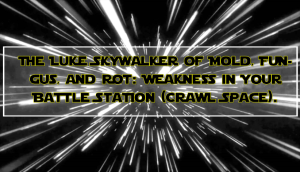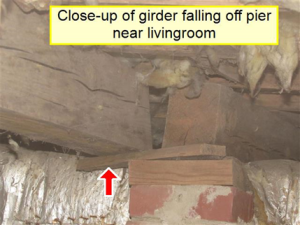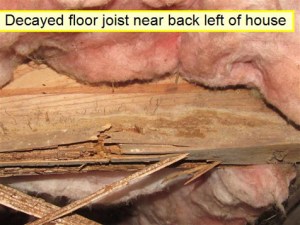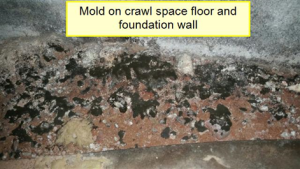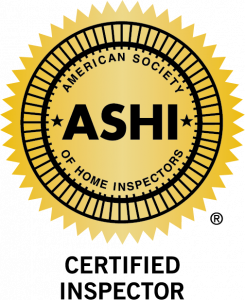The Luke Skywalker of Mold, Fungus, & Rot: Weakness in Your Battle Station (Crawl Space).
Every component of the home is important to examine in a home inspection. However, the one that is most crucial and where I spend a great deal of time is the crawl space and/or foundation. Allow me to get my Star Wars-nerd-on for the rest of this blog.
Your crawl space is just like the weakest area in the Death Star. In, Star Wars, ‘Return of the Jedi,’ there was a six-foot area at the heart of the battle station that was the weakest point in the entire structure. If this area is taken out the whole Death Star implodes and is destroyed. You know what happens next- Luke Skywalker and his squad eventually make their way to the center of the Death Star. Luke Skywalker fires a couple proton torpedoes into a small thermal exhaust port. BOOM! Direct hit! If you fail to be proactive in having your crawl space checked out, then the Luke Skywalker of mold, rotting wood, and fungus spores will wreak havoc on your foundation which could result in very expensive repairs and/or bodily harm to you and your family.
Recently I inspected a home where I found the main girder in the house falling off a brick pier. The main girder is the structural member that is holding up the floor joists and floor system of the home. If it fails, the floor joists and floor above can fail and end up in the basement or crawl space, along with you and the furniture.
On this same inspection, I also found several floor joists that had severe wood rot. Upon closer examination, I found wood destroying fungus on the joists that were eating the wood away. I also found a mold/fungal material growing on the CMU blocks and crawl space floor. The moisture level in the crawl space was high and I found water penetrating from the outside through the foundation wall. Bottom line, the floor system, crawl space, and foundation had been neglected for several years and thus, structural failure of the wood supporting framing had begun.
Many home owners don’t inspect their crawl spaces and fewer even visit. I don’t blame them. Very few dirt crawl spaces are easy to enter or maneuver around in. However, if you care about energy costs, rotting wood, mold or fungus spores, buckled floors, the foundation of your home and your overall health then you need to be concerned about your crawl space. At a minimum, you should have your crawl space inspected once per year. If you don’t want to inspect it yourself, I recommend hiring a professional to do it for you.
Many home owners contract with a licensed pest control company to conduct termite inspections once a year. Part of their inspection includes an inspection of the crawl space. Or, you can hire a licensed home inspector to conduct the inspection. If you decide to do it yourself, I will give you a few tips or areas to concentrate on.
- Observe the floor/ground for signs of water or moisture intrusion
- Does your crawl space have a vapor retarder? If not, I recommend installing one
- Move insulation away from the subfloor to observe possible leaks at plumbing waste pipes. Observe the areas under kitchens and baths where leaks can occur.
- Water can intrude at exterior doors, so pay particular attention to these areas while in the crawl space. Move insulation to observe the rim joist under all exterior doors and decks.
- Observe foundation walls for water intrusion. Look for a white powdery substance known as efflorescence. In extreme cases, water intrusion into a crawl space or foundation can lead to undermining of the foundation.
- Bring a long screw driver with you and hit the wood floor joists and outer rim joists with it. Try to puncture a hole in the joist with the screw driver to see if you have rot or decay.
- Do you have the older style metal insulated HVAC ducts? They tend to leak air, and as a result, in the summer months these types of ducts can sweat in crawl spaces causing water to drip from them. This can also lead to excess moisture in the crawl space.
Safety is key when inspection crawl spaces. At a minimum, you should wear a particulate mask like an N95. I wear a respirator with charcoal filters. I also wear gloves, hat, coveralls, and last, but not least are safety glasses. Things always seem to fall from the floor system. Because of this make sure to protect your eyes.
Remember, the most important part of your Death Star…I mean… home… is the foundation. Keeping it trouble free is a matter of observation and catching potential problems early. The foundation and floor system is holding up the rest of the house so if it’s unstable then your home is unstable. Make sure your crawl space is examined at least once a year. You don’t want the rebel alliance of mold, fungus, and rot to come against you and take out your home.

